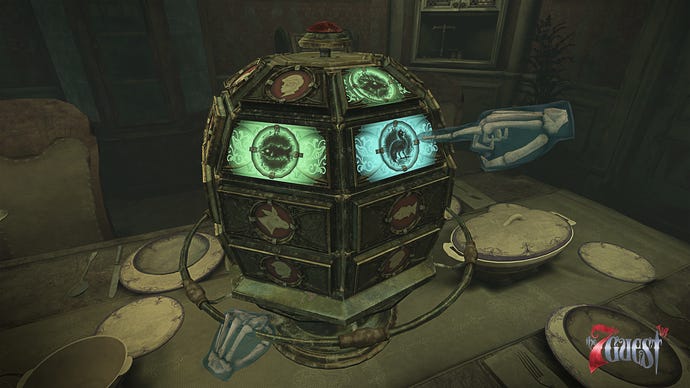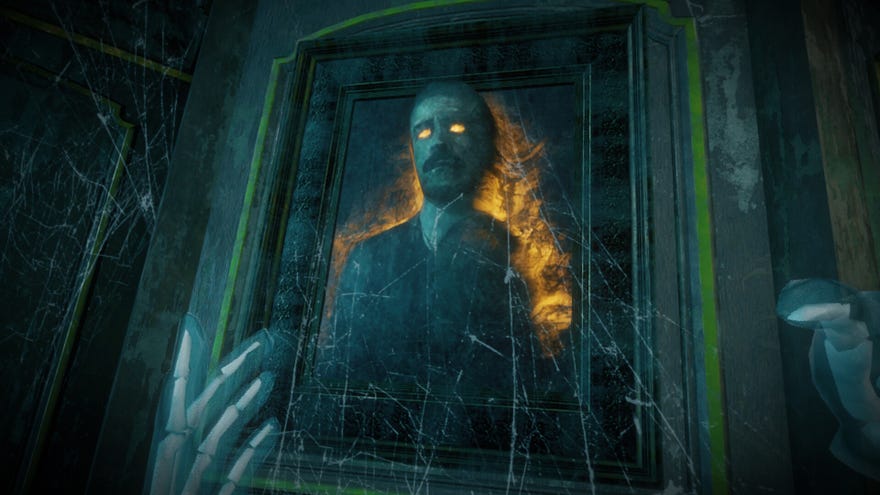Reality Bytes: The 7th Guest VR is a sumptuously spooky remake
Guest Room
Hallowe’en may be over (just), but for this month’s Reality Frights, I’ve got a wonderfully seasonal game for you. It’s the brand-new remake of the grand old mystery puzzler The 7th Guest, a game which Bill Gates notably referred to as “The new standard of interactive entertainment.” In fairness to ol’ William, he said this seven months before Doom blew out the new standard’s insides with a 12-gauge shotgun, shunting PC gamers’ tastes away from kitsch adventure games and toward grisly murder-fests. But The 7th Guest is nonetheless fondly remembered for its spooky atmosphere, alongside its blend of pre-rendered backgrounds and live action cutscenes you could call ‘pioneering’ had it not proved such an evolutionary dead end.
Today, the original 7th Guest looks more dated than Henry VIII, which is probably why this remake replaces everything but the very skeleton of the 1993 original. The game still takes place in a creepy mansion belonging to a murderous toymaker, and still involves six eccentric guests to the house searching for a missing boy named Tad. But it’s otherwise been completely rebuilt, with whole new puzzles and whole new mechanics, all designed to be experienced in first-person VR.
If you’ve played The Room VR, then The 7th Guest operates in a largely similar fashion, although unlike Fireproof’s game, The 7th Guest takes place in a single, contiguous location (it turns out the 7th guest is ‘irony’). It starts off with your character arriving at the Toymaker’s mansion via a rowboat, before proceeding across a rickety jetty up to the door of the mansion. Once inside, you move from room to room, solving puzzles that unlock more rooms and puzzles, with the events of the story delivered piecemeal as you progress.
What I most like about The 7th Guest is its atmosphere, though not necessarily for the reasons you might expect. The 7th Guest is not an especially scary game, certainly not compared to, say, playing Resi 7 or Alien Isolation in VR. But there is a funhouse spookiness to it. The mansion is a shameless pastiche of a haunted house, where everything is worn and paint-flecked and covered in a layer of dust so thick you could grab it by the fistful. In one of the game’s neater tricks, your character is equipped with a lantern that can puncture through the gloom, showing you the building in its prime. Shine it on a flowerpot, and the desiccated stems will burst into full bloom. But the lantern also twists reality, with paintings on the walls warping in strange (and occasionally silly) ways.

But the game’s most striking visual flourish is found in the guests themselves. Like the original game, the remake uses live-action recordings of actors rather than 3D character models to portray the six attendees to the toymaker’s deadly soiree. But these performances appear to be projected onto a 3D mesh to create a holographic effect. It’s remarkably effective, capturing every detail of the actor’s costume and movements in shimmering, stereoscopic FMV. It really does feel like you’re watching the memories of the house play out in front of you.
Crucially, this approach to performance capture feels like a stylistic choice, rather than a “look at what our tech can do” flex with no thought to implementation, which was the case with a lot of FMV games in the 90s. This applies elsewhere, too. The performances are a little hammy, but in a way that’s endearing rather than embarrassing, lending the game the vibes of a murder-mystery dinner party. Likewise, the soundtrack is classic adventure game fare, all plinking piano and plodding baseline. It all makes the mansion a really enjoyable place to spend time in which is especially crucial in a VR game.

As for the puzzles, they are a fun and varied assortment, although there is more room for improvement here. Each room of the house is a self-contained puzzle space, with each offering three to four conundrums each. As you’d expect from a VR game, the puzzles are highly tactile affairs. In the music room, for example, the puzzles include playing the keys of a harpsichord in a certain order, and waving your hand around a theremin to shatter pots on the mantlepiece. Intermingled with these are maze puzzles, number puzzles (including wine sudoku) and logic puzzles, such as placing eight queens on a chessboard without them being able to take one another. My favourites were in the magician Hamilton Temple’s guest room, which combines magic top hats and Portal’s portals for fun non-Euclidean shenanigans.
The magician’s puzzles also highlight The 7th Guest’s biggest flaw, however, namely that it lacks some interactive refinement. Teleporting your hand through a pair of top hats is a cool trick, but only when it works, as sometimes the game struggled to register exactly where my hand was. More generally, the game doesn’t like objects being moved around much. You have to place items exactly in designated puzzle spots for them to register, and if you don’t, it’ll quickly respawn back at its original location. This is important to stop you from losing items under furniture, but it can be annoying if you’re doing a puzzle that involves manipulating more than two things, and you briefly put one down only for it to be whisked back to the far side of the room.



There are a couple of smaller issues, too. The puzzles are always themed around the room they’re in, and are usually interconnected in some way. In the kitchen, for example, each puzzle rewards you with an ingredient required to make a recipe for a soup bubbling away on the hob, while the nursery is essentially one large puzzle revolving around a doll’s tea party. There are some rooms where the connections between the puzzles are fairly transient, however, and I found these tended to be the least satisfying to complete.
Finally, while I enjoyed the game’s approach to storytelling, the actual story that it tells is a little underwhelming. This is 100% a fault of the original game rather than the remake, but it is also exacerbated by 30 years’ worth of evolution in how games construct their narratives. Stauf, the evil toymaker who is the game’s main antagonist, feels about as threatening as the phrase “evil toymaker” makes him sound. What he ends up doing is actually pretty horrible, but it’s also far too pantomime to take seriously. His puzzles are similarly anodyne in the scare department. Fun as they are to solve, Jigsaw he is not. The worst thing that happens when you solve one is he gets a bit annoyed. I’m glad the game doesn’t try to make you jump every thirty seconds, but a few frights to keep you on your toes wouldn’t have gone amiss.
Fortunately, the scheming of the guests themselves makes up for the lack of bite to the central premise, especially when they start to show their own teeth in the game’s latter half. They’re also just fun characters, exactly the kind of exaggerated weirdos that populated early 90s adventure games. Indeed, The 7th Guest’s real triumph isn’t as a masterful horror or innovative puzzler, it’s how lets you step directly into an offbeat adventure game world. That’s the thing which makes it unique, that separates it from horror VR games out there, and I thoroughly enjoyed riding its cheesy, nostalgic ghost train.


